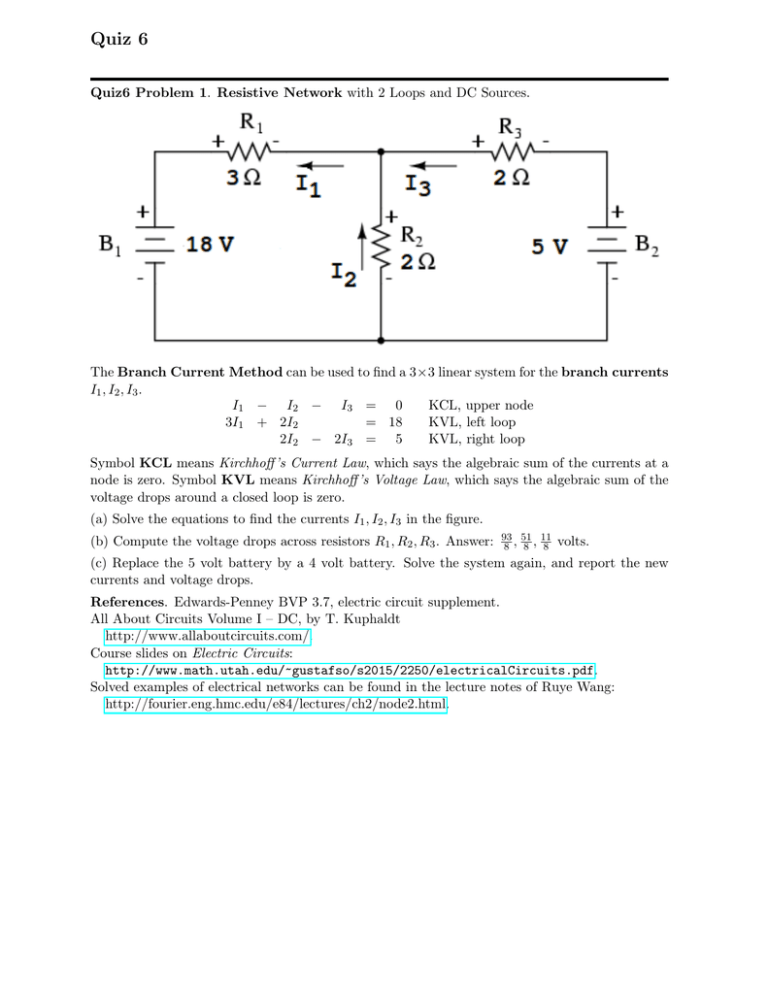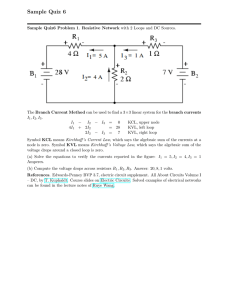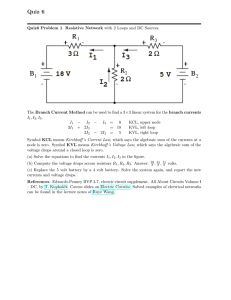Quiz 6
advertisement

Quiz 6 Quiz6 Problem 1. Resistive Network with 2 Loops and DC Sources. The Branch Current Method can be used to find a 3×3 linear system for the branch currents I1 , I2 , I3 . I1 − I2 − I3 = 0 KCL, upper node 3I1 + 2I2 = 18 KVL, left loop 2I2 − 2I3 = 5 KVL, right loop Symbol KCL means Kirchhoff ’s Current Law, which says the algebraic sum of the currents at a node is zero. Symbol KVL means Kirchhoff ’s Voltage Law, which says the algebraic sum of the voltage drops around a closed loop is zero. (a) Solve the equations to find the currents I1 , I2 , I3 in the figure. (b) Compute the voltage drops across resistors R1 , R2 , R3 . Answer: 93 51 11 8 , 8 , 8 volts. (c) Replace the 5 volt battery by a 4 volt battery. Solve the system again, and report the new currents and voltage drops. References. Edwards-Penney BVP 3.7, electric circuit supplement. All About Circuits Volume I – DC, by T. Kuphaldt http://www.allaboutcircuits.com/. Course slides on Electric Circuits: http://www.math.utah.edu/~gustafso/s2015/2250/electricalCircuits.pdf. Solved examples of electrical networks can be found in the lecture notes of Ruye Wang: http://fourier.eng.hmc.edu/e84/lectures/ch2/node2.html. Quiz6 Problem 2. Separation train: Xylene, Styrene, Toluene, and Benzene are separated in 3 distillation columns. Symbols F t, D, B, D1, B1, D2, B2 are molar flow rates in mol/min. Balance Equations. The four Xylene separations imply balance equation 0.05D1 + 0.16B1 + 0.15D2 + 0.24B2 = 0.15(70) kg-mol, based on 1 min of operation. There are 3 other similar equations, for styrene, toluene and benzene. Multiply by 100 to produce the balance equations Xylene: 5 D1 Styrene: 4 D1 Toluene: 51 D1 Benzene: 40 D1 + + + + 16 26 42 16 B1 B1 B1 B1 + + + + 15 10 54 21 D2 D2 D2 D2 + 24 B2 = 15(70) + 65 B2 = 25(70) + 10 B2 = 40(70) + 1 B2 = 20(70) Molar Flow Rates. Because D flows to column 2, then D = D1 + B1. Molar flow rates are computed individually in distillation column 2 as a linear combination of vector separations: Xylene molar flow rate Styrene molar flow rate Toluene molar flow rate Benzene molar flow rate D1 = 100 5 4 51 40 B1 + 100 16 26 42 16 . (a) Solve the balance equations for D1, B1, D2, B2. Answers: About 18.35, 3.91, 27.78, 19.95. (b) Compute the four individual molar flow rates for distillation column 2. Answers: About 1.5, 1.75, 11.0, 7.97. References. Edwards-Penney Sections 3.1, 3.2, 3.3. Course manuscript Linear Algebraic Equations, No Matrices: http://www.math.utah.edu/~gustafso/s2015/2250/linearequDRAFT.pdf. Michael Cutlip and Mordecai Shacham, Problem Solving in Chemical Engineering with Numerical Methods, Prentice-Hall (1998) ISBN-10: 0138625662. Quiz6 Extra Credit Problem 3. Traffic Flow Similar to electrical network analysis, traffic flow problems generate a system of equations A~x = ~b, but whereas the system of equations for the network has a unique solution, the traffic flow system of equations generally has infinitely many solutions. Traffic is measured in vehicles per hour (vph). A basic law is conservation of flow at an intersection, which compares to Kirchhoff’s laws for electrical networks. Here’s an example due to Gareth Williams for downtown Jacksonville, Florida, using rush hour data. The streets are Monroe, Laura, Duval, Hogan. The engineering mathematics text of Zill and Wright has details, found on the publisher’s two-page summary: http://math.jbpub.com/advancedengineering/docs/Project8.2 TrafficFlow.pdf. Downtown Traffic Flow in Jacksonville, Florida (a) Give the details for why the conservation law applied to each intersection implies the following equations. Assume all traffic flows x1 , x2 , x3 , x4 are nonnegative. x1 + x2 x1 x2 + x4 x3 + x4 + x3 = = = = 625, 475, 900, 1050. (b) Write the system in the form A~x = ~b and show the details for solving it. There are infinitely many solutions. The answer is x1 = 475 − t1 , x2 = 150 + t1 , x3 = 900 − t1 , x4 = t1 , where t1 is the invented symbol. (c) Explain why 0 ≤ t1 ≤ 475. (d) What is the minimum value of x3 along DC that would not lead to traffic congestion? Please explain the logic used. Answer: 425 vph. Therefore, road work on Monroe Street should allow traffic flow more than 425 vph. References. Edwards-Penney Sections 3.4, 3.5. Course manuscript Linear Algebraic Equations, No Matrices, Matrix Equations, Inverse Matrix and Matrix Multiply: http://www.math.utah.edu/~gustafso/s2015/2250/linearequDRAFT.pdf, http://www.math.utah.edu/~gustafso/s2015/2250/matrix-eqn.pdf, http://www.math.utah.edu/~gustafso/s2015/2250/inverseMethodRREF.pdf, http://www.math.utah.edu/~gustafso/s2015/2250/matrixOperations2008.pdf.

